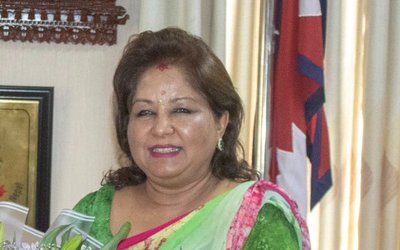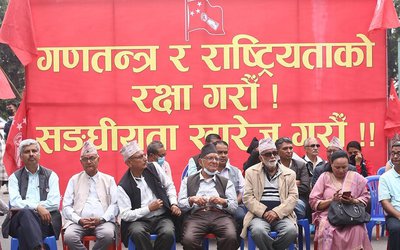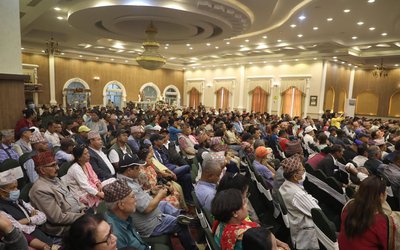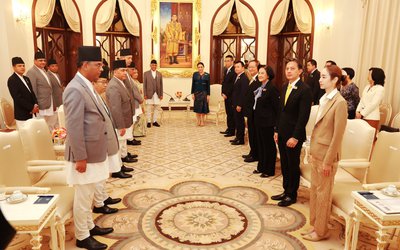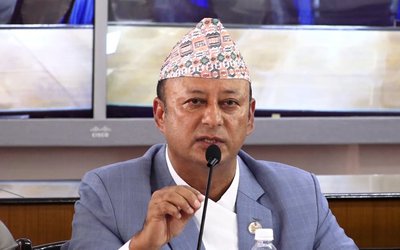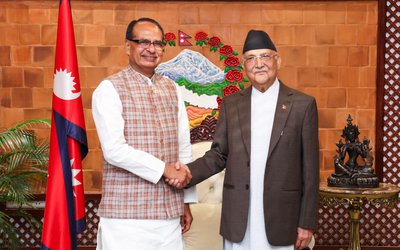
After the meeting between Indian Prime minister Narendra Modi and Pakistani prime minister Nawaj Shariff, the 18th SAARC Summit concluded adopting a 36-point Kathmandu Declaration with a pledge to deepen cooperation among member states in the core areas of trade, investment, finance, energy, infrastructure and connectivity.
When the 18th SAARC Summit inaugurated the situation was tense as the leaders of SAARC even did not come eye to eye. However, the finally the Summit concluded with good gesture. Although they did not hold talks, shaking hand in front of the world sent a positive gesture and save the SAARC somehow.
Although China has just an observer status, it has shown its dominate presence. It looms all over the summit as Indian media and officials closely monitored all the activities and moves made by China. With the massive investments and borders with five countries of South Asia, China’s presence felt strongly in 18th SAARC Summit. Despite a proposal by Pakistan to include China and South Korea as is full member, India was able to pre-empt the membership bid of China. It will remain to be seen how long India will keep China at bay.
With Prime Minister Sushil Koirala announcing conclusion of the SAARC summit on Thursday, all the heads of state and government took an opportunity for a group picture at the podium.
Indian Prime Minister Narendra Modi stood from his seat and first shook hands with Maldives´ President Abdulla Yameen Abdul Gayoom, who was seated next to Modi on the left. Other dignitaries also exchanged pleasantries with each other.
On the far-left, Pakistani Prime Minister Nawaz Sharif, who was talking to Nepal´s Foreign Minister Mahendra Pandey, advanced toward the direction where Modi, Koirala and other dignitaries were interacting. Modi also walked toward Sharif. Both the leaders then extended their hands almost simultaneously. They kept on shaking hands with a wide smile on their faces.
Syed Akbaruddin, spokesperson for the ministry of external affairs, India, posted the picture on Twitter. "The photo all were waiting for," he wrote on his timeline. Nepali, Indian and other international media highlighted the moment immediately.
It was a welcome break after continuous media coverage and speculations in social media that began since both the leaders cold-shouldered each other during the inaugural of the summit on Friday.
India's Prime Minister Narendra Modi has not welcomed Beijing's renewed suggestion its status be raised from "observer" in the South Asian Association for Regional Cooperation (SAARC), in which India is presently the only major power.
SAARC summits bring together leaders from Afghanistan, Bangladesh, Bhutan, India, the Maldives, Nepal, Pakistan and Sri Lanka.
Modi's hope of using the group as a counterweight to China is unlikely to gain traction at the two-day Kathmandu meeting, with officials saying Pakistan is blocking deals to increase transport and energy connections.
Pakistan mooted the idea of upgrading China's and South Korea's status in the organisation at a meeting of SAARC foreign ministers on Tuesday. It was quickly rebuffed by India.
"We need to first deepen cooperation among SAARC, before we try and move it horizontally," an Indian foreign ministry spokesman said. He said several countries agreed.
China has sent Vice Foreign Minister Liu Zhenmin and is expected to make a statement during the summit.
Earlier in the week, the Kathmandu bureau of Chinese state news agency Xinhua distributed a newspaper that devoted several pages to promoting China's full membership. The paper cited serving and former Nepali ministers expressing support for the proposal.
"China attaches great importance to SAARC's status and function," a Foreign Ministry spokeswoman told reporters in Beijing on Tuesday. "China is also willing to elevate the level of its relationship."
SAARC’s Commitment
The top leaders of the SAARC member states have also expressed commitment to reinvigorate SAARC´s regional cooperation and revitalize SAARC as an effective vehicle for fulfilling the developmental aspirations of the people living in South Asia.
With Nepal having successfully hosted the two-day 18th SAARC Summit, Pakistan has agreed to host the 19th Summit in accordance with the alphabetical rotational arrangement among member states for organizing this regional event. The 18th Summit has elected Nepal as the Chair of SAARC till the next Summit is held.
SAARC member states have now agreed to hold the Summit every two years against the provision made in the SAARC Charter for holding the Summit every year. The member states have also agreed to hold the Council of Ministers meeting (Foreign Minister level) once a year, the Standing Committee (Foreign Secretary level) meeting at least once a year and the Programming Committee (Joint Secretary level) meeting at least twice a year.
The Kathmandu Declaration has agreed to accelerate the process of creating a free trade region, formulate and implement the projects, programs and activities of SAARC in a prioritized, focused and result-oriented manner and launch regional and sub-regional projects in the agreed areas of cooperation, mainly in the areas of poverty alleviation, infrastructure building, connectivity and energy. The SAARC member states have agreed to strengthen the SAARC Development Fund and ensure effective implementation of the SAARC Action Plan on Poverty Alleviation with a view to make South Asia free from poverty and hunger.
SAARC Summit has directed the SAFTA Ministerial Council and SAFTA Committee of Experts to accelerate free trade in goods and services in the region, putting into operation simplified and transparent rules of origin; implementation of trade facilitation measures; harmonization of standards relating to technical barriers to trade; and elimination of non-tariff and para-tariff barriers. The leaders renewed their commitment to achieving a South Asian Economic Union (SAEU) in a phased and planned manner through a Free Trade Area, a Customs Union, a Common Market, and a Common Economic and Monetary Union.
On the connectivity front, the SAARC member states have renewed their commitment to substantially enhance regional connectivity in a seamless manner through building and upgrading roads, railways, waterways infrastructure, energy grids, and communications and air links to ensure smooth cross-border flow of goods, services, capital, technology and people. The leaders emphasized the need for linking South Asia with contiguous regions, including Central Asia and beyond by all modes of connectivity and directed the relevant authorities to initiate national, regional and sub-regional measures and necessary arrangements, the Declaration states.
Although the SAARC member states were expected to sign three SAARC Framework Agreements on motor-vehicles, railways and energy cooperation, only one agreement - on energy cooperation (electricity) - could be signed during the Summit. The Heads of State or Government have agreed to hold a meeting of the Transport Ministers within three months in order to finalize the Agreements on SAARC Motor Vehicles and SAARC Regional Railways.
In view of South Asia continuing to face threats from terrorism, the leaders have resolved to combat terrorism in all its forms and manifestations and ensure effective cooperation among the member states for preventing trafficking in persons, arms and drugs and exploitation of children for forced labor. The member states also agreed to utilizing the youth power for socio-economic development, especially through creation of employment opportunities at home and building collective positions for their security and welfare while on employment outside the region.
Increasing agricultural productivity and ensuring food and nutritional security, providing quality education, eliminating illiteracy, providing vocational education and training and making South Asia an attractive common tourist destination by promoting public-private partnership are among the important resolves coming out of the Kathmandu Summit.
The Summit decided to close down three Regional Centres, namely SAARC Documentation Centre in New Delhi, SAARC Human Resource Development Centre in Islamabad and SAARC Information Centre (SIC) in Kathmandu and transfer their mandates to the Secretariat and other mechanisms as part of reform at SAARC institutions and mechanisms for making them more efficient, effective and result-oriented.
They have also decided to merge four Regional Centres, namely SAARC Coastal Zone Management Centre, SAARC Meteorological Research Centre, SAARC Forestry Centre and SAARC Disaster Management Centre, and create a new Centre named ´SAARC Environment and Disaster Management Centre´. The location of the Centre is yet to be decided.
- IME GROUP: Expands Into Paper Industry
- Mar 24, 2025
- CPN UML: Instigated By India
- Mar 23, 2025
- ADB’S CHIEF ECONOMIST: Nepal Reduces Poverty
- Mar 11, 2025
- FM DR. DEUBA: A Successful Visit
- Mar 11, 2025
- MD GHISING: Target Of Personal Grudge
- Mar 09, 2025
